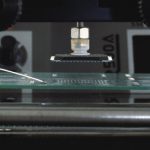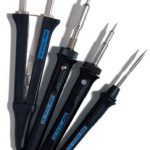The BGA is here to stay! Five years ago the industry was not so sure about the staying power of this revolutionary component packaging design. Today, there is no longer any dispute. The only question remains: how can every operator conduct proper BGA rework in a process controlled and cost effective manner?
Mark Cannon, general manager, Soldering Tools Division, Ersa Löttechnik GmbH, Wertheim, Germany
The Ersa IR 500 A was specifically designed to be ”the answer” to today’s rework and repair problems: a semi-automatic PCB rework station designed for every operator, every workbench, and every budget. User-friendly operation is the key to increasing productivity and achieving repeatable results. Second only to optimal process controlled performance, is operator ease of use that drove the engineering of the station. Every operator, in every shift, and with any skill level, should be capable of achieving the same results with speed, safety, and comfort.
A total semi-automatic PCB rework station for every workbench must be designed with size and flexibility in mind. The compact size of the base unit takes up little more work space than a notebook (300×280 mm) and weighs only 7 kg. The flexibility of this revolutionary, all inclusive system, is unparalleled in the industry by providing the tools for every soldering application imaginable.
Today’s semi-automatic BGA and SMT rework stations are generally large, require highly skilled operators, represent a significant capital investment, and demand tremendous additional costs for a wide selection of required nozzles. A total solution priced for every operator, every workbench and every budget: the IR 500 A does not only require any nozzles, it was specifically engineered with the price in mind.
Unlike the myriad of hot air systems on the market, which require a different nozzle for every different component, the use of dark IR radiators allows Ersa to greatly reduce operational costs. The top IR radiator has a patented XY aperture system that negates the use of nozzles or templates. All sizes and shapes of components from 10 to 50mm in length can be rapidly and safely removed or installed without unnecessary overheating of adjacent components. A simple setting of the XY aperture on the top IR radiator is all that is needed – no nozzles are required.
Advantage of dark and IR radiators
In contrast to hot air systems, the Ersa dark IR radiators guarantee uniform absorption, and even heating across the entire surface of the component and substrate. Uniform heating is essential for process controlled installations of BGAs. In contrast to systems using visible or light IR (short wavelength), dark IR radiators are specifically designed for PCB applications. Light IR causes an uneven absorption/reflection ratio between objects darker in color and objects lighter in color. This can lead to overheating of the component body and substrate before reflow has been achieved at the leads. The top and bottom dark IR radiators are medium wavelength, 2 to 8µm, which have been proven to have the optimal absorption/reflection ratio between dark and light colors. The component body, substrate, and leads are safely and evenly heated, reducing any risk of damage during the soldering or desoldering process.
Auto-IR-concept
Safety, ease-of-use, and repeatable results by all operators were the driving forces behind the Auto-IR-concept. The component to be removed is rapidly located with the help of a fixed axis laser positioning device, and is precisely positioned in the middle of the top and bottom IR radiators. A spring supported vacuum pipette, which is centered in the top IR radiator, is automatically placed on the center of the component. When reflow is achieved, the component is automatically lifted off the board, thereby reducing any risk of overheating – no contact, no fuss, no risk of damage. The complete stand-alone system is designed for every rework application. No special training or additional items are required. The user-friendly station will assist step-by-step and ensure that all operators conduct process controlled rework in minutes:
– Place PCB in holder, slide into position whereby the laser point is located in the middle of component (PCB level and height adjustment possible). Position K-type thermal couple rod on surface of PCB next to component (digital display will indicate temperature ramp rate).
– Rotate and lower top IR radiator. Component is automatically centered between top and bottom IR radiators.
– Click mouse to start vacuum and press spring actuated vacuum cup onto component.
– Component automatically lifts off at reflow!
Hot air versus dark IR
The desoldering and soldering process of BGA and Micro BGA components is handled according to the CECC standard method for the specification of SMDs of assessed quality – CECC 00807. The majority of the BGA rework stations on the market use hot air to transfer heat through the component body to the solder balls, or try to blow hot air under the component. Unlike hot air systems, which often warp boards or burn adjacent plastic or temperature sensitive components, Ersa´s dark IR technology guarantees a safe process.
It is paramount, however, that the heat transfer medium (air or gas) be uniformly distributed across the entire surface of the BGA. Air flow dynamics dictate that as hot air blows through the nozzle, it rotates or has a rifling effect that causes an increased heating pattern along the walls of the nozzle. This heating pattern is no, and physically cannot be, uniform. While such a heat transfer mechanism is marginally acceptable for a PQFP or external leaded device, it is completely unacceptable for BGAs. The solder balls located in the center of the component inevitably receive insufficient heat. The top of the line rework stations, which have specially designed nozzles that blow hot air under the BGA, have the problem of overheating the leads close to the edge of the component before reflow can be achieved in the center. This physical effect cannot be avoided. Temperature of the air flow is always higher, closer to the heating element
Total flexibility
The Ersa dark IR radiators achieve a uniform heating across the entire surface of the BGA component, thereby approaching a reproduction of the machine reflow process. The unit is equipped with an RS-232 serial port and the option to connect from 2 up to 32 thermal couples to the component body, substrate top or bottom side, or wherever desired. The optional process control software can document precise thermal profiles of all soldering and desoldering operations for ISO 9000 procedures.
Total flexibility means being able to handle any job in a safe and controlled manner. The IR 500 A can replace practically every soldering tool, station, etc., on the workbench. The integration of the top-of-the-line soldering station Micro-Con 60 iA offers the expansion of the unit to include a total of 4 various tools to handle essentially every rework, repair and soldering application.
Specific soldering applications need specific soldering tools. Cleaning of pads requires a soldering or desoldering iron with special tips. Chip removal and replacement are most effectively accomplished with a light weight, high power thermal tweezing tool and the appropriate tips. Ultra-fine-pitch installation and/or touch up, i.e. bridge removal, is rapidly done with one of the specially designed SolderWell tips for any one of the three light weight, high power temperature controlled soldering irons that can be connected to the unit. Low temperature removal, replacement, and touch up with any of the optional tools are safe and easy. The bottom side dark IR radiator is the perfect preheat system for the most difficult of PCB substrates.
The compact size provides an ideal workplace with integrated PCB holder and bottom side preheating for touch-up and any other hand soldering job. From ultra-fine-pitch to high-mass aluminum housings, from temperature sensitive flex and polyamid substrate to the heaviest multilayer, from 0402 micro-chips, SMD and thru-hole sockets, to pin grid array and BGA, the IR 500 A is the answer to total flexibility.
Fax +49 9342-800-13
Keine Frage, der BGA-Einsatz ist zu einer Haupströmung in der hochvolumigen Baugruppenfertigung geworden. Doch ist das kritische Bauteil, speziell der µBGA, bei Reparatur und Instandsetzung sehr sorgfältig zu behandeln, schließlich soll Rework die Qualitätsmaßnahmen nach ISO 9000 nicht aufweichen.
Il va sans dire que l’emploi du BGA est de première importance dans la masse énorme de fabrication en sous-groupes. Cependant cet élément critique, spécialement le µBGA, est à manier avec précaution pour les réparations et les dépannages; le Rework ne doit pas en effet rabaisser le niveau des mesures prises pour assurer la qualité selon ISO 9000 (technique de soudure ERSA).
L’utilizzo del BGA è diventato senza dubbio l’elemento principale della produzione su larga scala di unità d’assemblaggio. Tuttavia il componente critico, specialmente di (BGA, deve essere trattato in modo molto accorto in caso di riparazione; la Rework infine deve rispettare le norme di qualità previste dalla ISO 9000 (tecnica di saldatura Ersa)
Unsere Webinar-Empfehlung
Auch dieses Jahr präsentiert Koh Young wieder aktuelle Trends und „State of the Art“ Technologie aus der optischen Inspektion und 3D-Messung auf der Productronica in München. Aber wir alle kennen das Problem voller Terminkalender, Reisebeschränkungen oder fehlender Zeit, um in…
Teilen:






.png)







